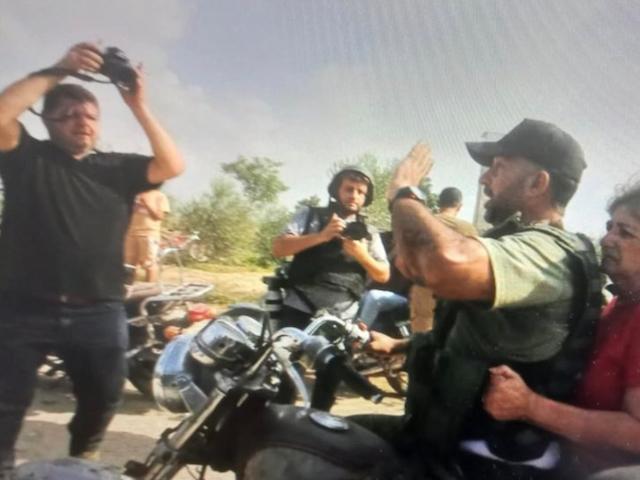The discourse surrounding Israel's military actions in the Gaza Strip has introduced a deeply troubling accusation into the media landscape, suggesting a targeted campaign against journalists by Israeli forces. This claim, suggesting Israel has been responsible for the deaths of nearly 100 journalists during its conflict with Hamas, not only challenges the integrity of Israeli military operations but also raises significant concerns about freedom of the press and the safety of journalists in conflict zones.
David Collier, a UK-based journalist, offers a critical analysis of these allegations in his report, “The Journalists of Gaza: A Modern-Day Antisemitic Conspiracy Theory Promoted by Mainstream Media.” Collier's investigation reveals a stark discrepancy between reported figures and the reality on the ground, suggesting that the actual number of journalists killed is closer to 15, a figure significantly lower than the numbers propagated by media outlets.
If it wasn’t for Al Jazeera, Middle Eastern Eye and Middle East Monitor, there would be a lot less propaganda being spread.
— NJA (@NJA_UK) February 27, 2024
2 of Al-Jazeera’s reporters in Gaza were found to be Hamas terrorists. https://t.co/nyjNRgtBrC
The foundation of these allegations lies in two primary sources: the Gaza Media Office, effectively a mouthpiece for Hamas, and the Committee to Protect Journalists (CPJ), a New York-based NGO. Collier's research indicates that the CPJ's list of deceased journalists largely mirrors that of the Gaza Media Office, suggesting an uncritical acceptance of data provided by an organization with vested interests in the conflict's portrayal.
This uncritical acceptance of Hamas-provided data by Western NGOs and media outlets, as Collier suggests, not only undermines the credibility of these institutions but also serves to amplify Hamas propaganda. By failing to rigorously vet the information provided by these sources, organizations like the CPJ inadvertently contribute to a narrative that paints Israeli military efforts in an indiscriminately violent light, without due consideration for the complexities of the conflict and the efforts made to avoid civilian casualties.
The full report lists all of the dead alleged journalists and describes their affiliations. Many of whom never seem to have actually done any journalism, and they might have received their job titles after they died, so Hamas could gain more points https://t.co/diiaOitV7v
— Yosef Hartuv (@LoveoftheLand) February 28, 2024
Collier's investigation further reveals that a significant portion of the individuals listed as journalists by the CPJ were, in fact, affiliated with proscribed terror organizations, including Hamas and Palestinian Islamic Jihad. This affiliation raises critical questions about the criteria used to classify individuals as journalists and the implications of such classifications for understanding the nature of the conflict.
The case of Hassuna Salim, who was reported to have issued a call to arms on behalf of Islamic Jihad, exemplifies the blurred lines between journalism and active participation in terrorist activities. This conflation of roles challenges the very notion of journalistic neutrality and integrity, suggesting that some individuals may exploit their purported status as journalists to further the objectives of terror organizations.
Media outlets have been widely covering the deaths of the Palestinian journalists killed during the Israel-Hamas war. So we wrote a list... BUT we included which terror groups they were affiliated with.https://t.co/MpytFclhKS
— HonestReporting (@HonestReporting) February 23, 2024
Furthermore, the narrative surrounding the targeted killings of journalists in Gaza often fails to account for the complex operational realities faced by the Israeli military. The deaths of individuals within their homes, rather than in direct combat or journalistic activities, point to the broader strategy employed by terror organizations of embedding within civilian populations, thereby complicating efforts to target legitimate military objectives while minimizing civilian casualties.
It's bad enough that @longislandu is awarding Yousef Masoud, who infiltrated Israel on Oct 7. But to brazenly ignore the barbaric massacre committed by Hamas that led to the war in Gaza which, in LIU's words, these two documented "from its opening hours" is beyond despicable. pic.twitter.com/snRgvPBsVA
— Israel War Room (@IsraelWarRoom) February 22, 2024
The refusal of organizations like the CPJ to engage in dialogue or reevaluate their methodologies, as indicated by their declined interview requests, underscores a broader issue of accountability and transparency within the NGO sector. By adhering to a narrative that uncritically accepts data provided by sources with clear biases, these organizations risk compromising their mission to protect journalists and uphold the standards of objective reporting.
American Oct. 7 Survivors Sue AP For Aiding & Abetting Hamas
— Breaking News (@TheNewsTrending) February 23, 2024
Several survivors of the October 7th Hamas massacre are suing the Associated Press of aiding and abetting Hamas by using freelance journalists embedded in the murderous terror organization. pic.twitter.com/Tji6U8riHx
Further complicating the issue are instances of misleading reporting by reputable international media outlets, which have been accused of uncritically accepting and amplifying claims made by Hamas or related entities. HonestReporting, an organization dedicated to scrutinizing media coverage of Israel, has highlighted discrepancies and potential biases in the reporting of events by The New York Times, including the coverage of individuals like Yousef Masoud, a photographer whose activities and affiliations have been questioned.
This is the metadata accompanying Masoud's photo of Palestinians standing atop a tank east of the security fence inside Israel. It was taken at 6:41 a.m., 13 minutes after the attack began. pic.twitter.com/MkmyRQCnzY
— HonestReporting (@HonestReporting) February 27, 2024
The discussion surrounding the deaths of journalists in Gaza is emblematic of broader issues related to media coverage of the Israeli-Palestinian conflict. It highlights the necessity for rigorous verification of claims as it relates to information coming out of the Hamas-run Gaza Strip where much of the information is being issued by Hamas's propoganda wing. The importance of distinguishing between combatants and non-combatants in conflict reporting, and the impact of propaganda on international perceptions of the conflict. As accusations of targeting journalists intertwine with the realities of warfare and propaganda, the need for transparency, accountability, and critical scrutiny in conflict reporting becomes ever more apparent.


